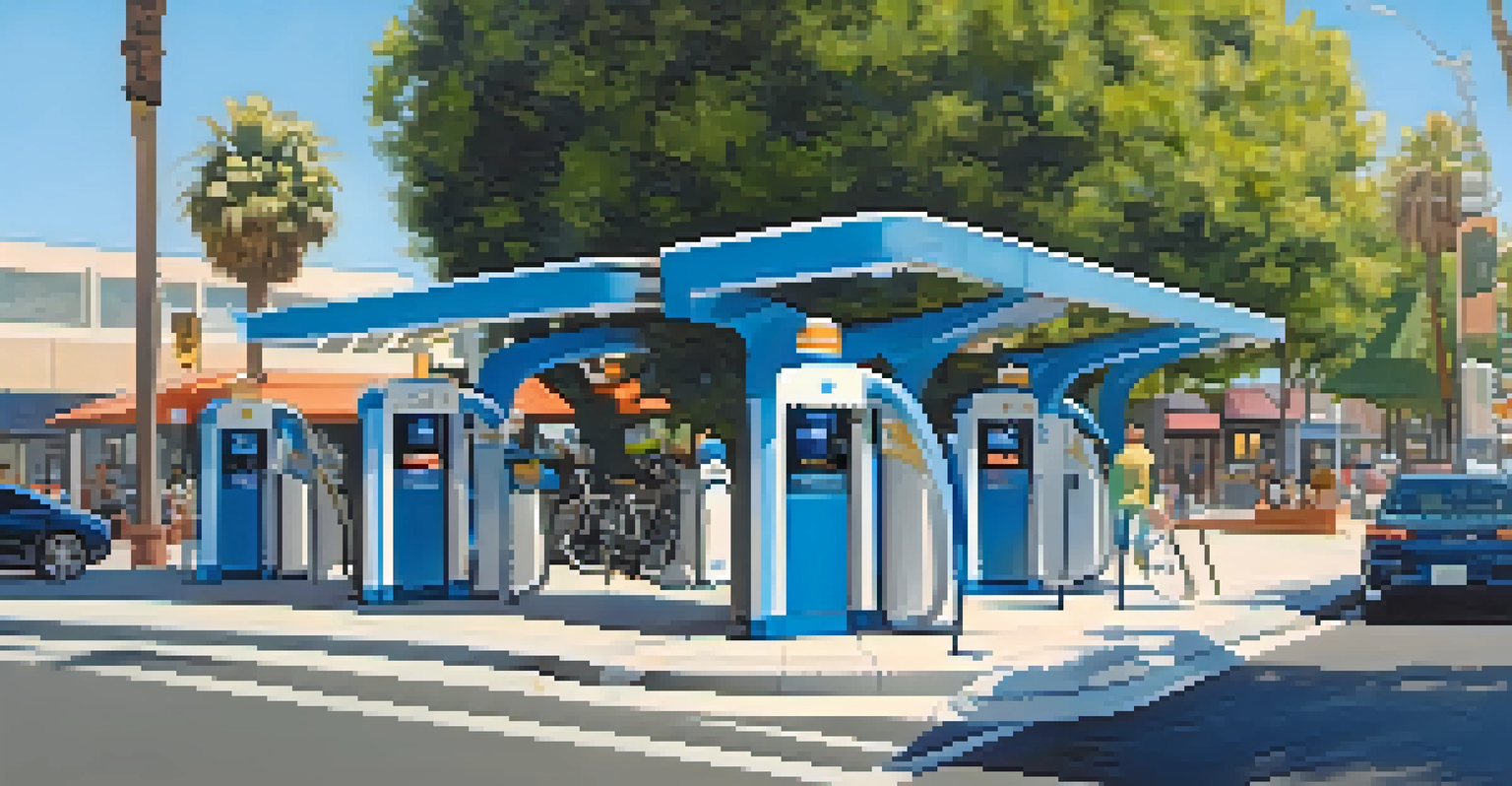Santa Monica's Climate Action Plan: Strategies for a Greener Future

Understanding Santa Monica's Climate Action Plan
Santa Monica's Climate Action Plan (CAP) is a comprehensive strategy aimed at reducing greenhouse gas emissions and promoting sustainability. Launched in 2019, this plan is part of the city’s commitment to creating a resilient and eco-friendly community. By integrating various sectors such as transportation, energy, and waste management, the CAP sets ambitious targets to tackle climate change effectively.
The greatest threat to our planet is the belief that someone else will save it.
The plan not only addresses environmental concerns but also prioritizes social equity and community involvement. By engaging residents and local businesses, Santa Monica aims to foster a culture of sustainability that benefits everyone. This collaborative approach ensures that the voices of the community are heard and incorporated into actionable strategies.
Overall, the CAP serves as a roadmap for Santa Monica to transition into a greener future. It not only outlines specific goals but also provides a framework for measuring progress and making necessary adjustments. For residents and stakeholders alike, understanding this plan is crucial for participating in the city’s sustainability journey.
Key Goals of the Climate Action Plan
At the heart of Santa Monica's Climate Action Plan are its key goals, which include achieving carbon neutrality by 2030. This ambitious target reflects the city’s determination to lead by example in the fight against climate change. By reducing emissions through various initiatives, Santa Monica aims to set a standard for other cities to follow.

Additionally, the plan emphasizes the importance of increasing energy efficiency across homes and businesses. By promoting the use of renewable energy sources, such as solar power, the city hopes to significantly cut down on fossil fuel dependency. This shift not only benefits the environment but also provides long-term savings for residents.
Santa Monica Aims for Carbon Neutrality
The city has set an ambitious goal to achieve carbon neutrality by 2030, showcasing its commitment to leading in climate action.
Another crucial goal is to improve mobility and reduce reliance on cars. The CAP aims to enhance public transportation options, encourage biking and walking, and promote electric vehicles. By making these changes, Santa Monica seeks to create a more connected and sustainable urban environment.
Strategies for Reducing Greenhouse Gas Emissions
One of the core strategies of the Climate Action Plan is to implement energy-efficient building practices. By updating building codes and encouraging retrofits, Santa Monica aims to minimize energy consumption in both residential and commercial properties. These efforts not only reduce emissions but also enhance the overall comfort and value of buildings.
We do not inherit the earth from our ancestors, we borrow it from our children.
Furthermore, the city is investing in green infrastructure, such as urban forests and green roofs. These initiatives serve multiple purposes, including improving air quality, reducing heat island effects, and providing habitat for local wildlife. By integrating nature into urban spaces, Santa Monica fosters both environmental and community health.
Public engagement plays a significant role in emission reduction as well. Through educational programs and community workshops, the city encourages residents to adopt sustainable practices in their daily lives. By empowering individuals to take action, Santa Monica builds a stronger, more resilient community.
Community Engagement and Collaboration
Community engagement is a cornerstone of Santa Monica's Climate Action Plan. The city actively seeks input from residents, businesses, and local organizations to shape its sustainability initiatives. This collaborative approach not only builds trust but also ensures that diverse perspectives are considered in decision-making processes.
Workshops and public forums are regularly held to educate the community about the importance of climate action and how they can contribute. These events foster a sense of ownership among residents, making them feel more invested in the city's goals. The more people understand the challenges and solutions, the more likely they are to participate actively.
Community Engagement Drives Success
Santa Monica prioritizes community involvement through workshops and partnerships to ensure diverse perspectives shape sustainability initiatives.
Moreover, partnerships with local nonprofits and educational institutions help amplify the impact of the CAP. By working together, these organizations can leverage resources, share expertise, and reach wider audiences. This collaborative spirit is essential for creating lasting change and fostering a culture of sustainability.
Sustainable Transportation Initiatives
Transportation is a significant contributor to greenhouse gas emissions, and Santa Monica's Climate Action Plan addresses this challenge head-on. One of the key initiatives is to enhance public transit options, making it more accessible and convenient for residents. By improving bus routes and schedules, the city encourages more people to opt for public transportation.
Additionally, the plan promotes the use of bicycles and walking as viable alternatives to driving. Expanding bike lanes and pedestrian pathways not only supports healthier lifestyles but also reduces traffic congestion and emissions. These improvements make Santa Monica a more walkable and bike-friendly city, enhancing the overall quality of life.
Electric vehicle (EV) infrastructure is another crucial component of the transportation strategy. By installing more EV charging stations throughout the city, Santa Monica aims to encourage residents to switch to electric vehicles. This shift is vital for reducing emissions and supporting the transition to cleaner energy sources.
Waste Management and Reduction Strategies
Effective waste management is key to achieving Santa Monica's sustainability goals. The Climate Action Plan outlines strategies for reducing waste and increasing recycling rates in the community. By promoting composting and reducing single-use plastics, the city aims to divert significant amounts of waste from landfills.
Initiatives such as community clean-up events and recycling education programs play a crucial role in engaging residents in waste reduction efforts. These events not only raise awareness but also foster a sense of community pride and responsibility. When residents see the impact of their actions, they are more likely to make sustainable choices.
Innovative Waste Management Strategies
The Climate Action Plan includes innovative waste reduction strategies, such as promoting composting and investing in smart waste technologies.
Moreover, the city is exploring innovative technologies to improve waste management processes. By investing in smart waste collection systems and recycling facilities, Santa Monica aims to enhance efficiency and reduce environmental impact. These advancements reflect a forward-thinking approach to sustainability, setting an example for other cities.
Measuring Progress and Ensuring Accountability
To ensure the effectiveness of the Climate Action Plan, Santa Monica has established a framework for measuring progress. Regular assessments help the city track its emissions reductions and evaluate the success of various initiatives. This data-driven approach allows for informed decision-making and adjustments to strategies as needed.
Transparency is also a priority, with regular reports shared with the community to keep residents informed about progress. By showcasing achievements and challenges, the city fosters trust and encourages continued engagement. Residents can see firsthand how their efforts contribute to the overall goals of the Climate Action Plan.

Additionally, partnerships with academic institutions and environmental organizations provide valuable insights and resources for monitoring progress. By collaborating with experts, Santa Monica can ensure that its strategies are grounded in research and best practices. This commitment to accountability strengthens the city’s dedication to a sustainable future.